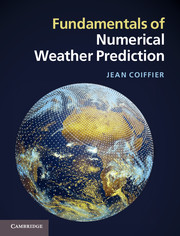Book contents
- Frontmatter
- Contents
- Foreword to the French Edition
- Foreword to the English Edition
- Preface
- Acknowledgments
- Partial list of symbols
- 1 Half a century of numerical weather prediction
- 2 Weather prediction equations
- 3 Finite differences
- 4 Spectral methods
- 5 The effects of discretization
- 6 Barotropic models
- 7 Baroclinic model equations
- 8 Some baroclinic models
- 9 Physical parameterizations
- 10 Operational forecasting
- Appendix A Examples of nonhydrostatic models
- Further reading
- References
- Index
2 - Weather prediction equations
Published online by Cambridge University Press: 05 June 2012
- Frontmatter
- Contents
- Foreword to the French Edition
- Foreword to the English Edition
- Preface
- Acknowledgments
- Partial list of symbols
- 1 Half a century of numerical weather prediction
- 2 Weather prediction equations
- 3 Finite differences
- 4 Spectral methods
- 5 The effects of discretization
- 6 Barotropic models
- 7 Baroclinic model equations
- 8 Some baroclinic models
- 9 Physical parameterizations
- 10 Operational forecasting
- Appendix A Examples of nonhydrostatic models
- Further reading
- References
- Index
Summary
Introduction
The equations used to build the various types of model simulating the evolution of the atmosphere are obtained from the basic general equations by making a number of simplifications. These simplifications are justified by analysis of the order of magnitude of the various terms in the equations for the scales to be represented (see Table 1.1) and by the degree of simplification to be achieved so as to simulate the behaviour of the atmosphere.
From the equations describing the behaviour of a nonviscous fluid (also known as the Euler equations), the traditional approximation in meteorology consists in approximating the atmosphere to a thin layer and leads to a system of nonhydrostatic equations that allows for the proper handling of mesoscale atmospheric motion in particular. The hydrostatic approximation consists in neglecting vertical acceleration and leads to what are called the primitive equations (as opposed to the filtered equations, which involve an additional hypothesis of balance between mass and wind fields and that were used to build the first operational numerical models). Although they do not allow convective motion to be simulated explicitly, the primitive equations are widely used both for weather forecasting models and for general atmospheric circulation models.
- Type
- Chapter
- Information
- Fundamentals of Numerical Weather Prediction , pp. 15 - 38Publisher: Cambridge University PressPrint publication year: 2011
- 4
- Cited by



